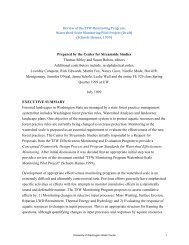Copyright 2012 Aileen M. Echiverri-Cohen - University of Washington
Copyright 2012 Aileen M. Echiverri-Cohen - University of Washington
Copyright 2012 Aileen M. Echiverri-Cohen - University of Washington
Create successful ePaper yourself
Turn your PDF publications into a flip-book with our unique Google optimized e-Paper software.
instructed to revisit the trauma as vividly as possible for a duration <strong>of</strong> 45-60 min. After imaginal<br />
exposure, the therapist and client discussed major themes <strong>of</strong> the imaginal exposure, and in vivo<br />
and imaginal exposure exercises were assigned for practice between sessions. Session 10<br />
consisted <strong>of</strong> imaginal exposure followed by relapse prevention and termination. Master’s and<br />
doctoral level clinical psychologists received formal training with experts in PE (Drs. Edna Foa,<br />
Lori Zoellner, and Norah Feeny). Treatment standardization was achieved through weekly<br />
supervision, joint cross-training sessions, and outside treatment fidelity ratings. Specifically,<br />
assessment <strong>of</strong> treatment adherence for PE was conducted for 10% <strong>of</strong> the cases by an outside<br />
expert. For this sample, fidelity for PE was high, with 92.3% adherence to imaginal exposure, in-<br />
vivo exposure, and processing components in PE.<br />
Sertraline (SER) consisted <strong>of</strong> 10 weekly sessions with a board certified psychiatrist who<br />
monitored response to medication and <strong>of</strong>fered general support based on a modified treatment<br />
manual used in previous medication studies (Marshall & Lockwood, 2002). In the first session<br />
(45 min), the study psychiatrist reviewed the client’s trauma history and discussed the role <strong>of</strong><br />
medication in reducing PTSD symptoms. Subsequent sessions ran 15-30 min where current<br />
symptoms and side effects were assessed. The final session included medication management<br />
and termination, with the encouragement for those who respond to stay on the medication for at<br />
least one year (Davidson et al., 2001). Psychiatrists started with 25 mg/day for one week, and<br />
then the dose was titrated each week by 50 mg until the maximum dose <strong>of</strong> 200 mg/day was met<br />
at Session 5, as indicated by a standard titration algorithm used in previous clinical trials (i.e., 50<br />
- 200 mg; Brady et al., 2000; Davidson et al., 2001). Sertraline was titrated up based on the<br />
client’s tolerance and was reduced or discontinued for clients that experienced significant side<br />
effects. Similarly, treatment adherence was evaluated by an outside rater who viewed 15% <strong>of</strong> the<br />
24
















